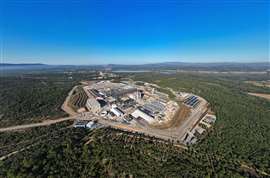ITER announces new construction timetable
25 June 2024
Plans to build the world’s largest nuclear fusion experiment in southern France have been put back as a result of the Covid pandemic and problems with first-of-a kind components.
Teams building ITER (the International Thermonuclear Experimental Reactor), in Provence have published an updated timeline for the project which aims for a “scientifically and technically robust phase of operations, including deuterium-deuterium fusion production in 2035 followed by full magnetic energy and plasma current operation.
 An aerial view of the 180 hectare site of the International Thermonuclear Experimental Reactor (ITER) project Photo: ITER
An aerial view of the 180 hectare site of the International Thermonuclear Experimental Reactor (ITER) project Photo: ITER
The previous baseline for the project, established in 2016, aimed to have the first plasma produced at the mega project in 2025 and the first deuterium-tritium operations in 2035.
Deuterium and tritium are both isotopes of hydrogen.
At the 34th meeting of the ITER Council on 20 June, ITER director general Pietro Barabaschi said that the new baseline would prioritise the start of substantial research operations by consolidating the tokamak assembly stages, enhancing pre-assembly testing and reducing machine assembly and commissioning risks.
“The proposed baseline will be further evaluated and validated, including the increased cost and the schedule implications driven by this new approach and recommendations shared with the ITER Council for consideration,” ITER said in a press release, which added that the director general will provide more details about the updated timetable at a press conference in July.
Construction on the project began in 2010, with an estimated completion date of 2018.
Under 2016 baseline plans, ITER had proposed a lower energy start to operations which would have meant certain components required for high energy operations could be installed later.
If it ultimately succeeds in its mission to deliver a tenfold return on power input (ie 500MW of fusion power output from 50MW of input heating power), ITER will have proven fusion’s potential to completely revolutionise the global energy landscape.
Late in 2022, it was announced that defects had been detected in the thermal shields that were manufactured during Covid. These shields will insulate the super-cold superconducting magnets from the super-hot plasma inside the tokamak.
Cracks in thermal piping were found; cracks so small they had to be identified using X-ray tomography, which was developed in collaboration with research engineers at CERN in Switzerland. Ultimately, some 23km of piping has had to be replaced.



